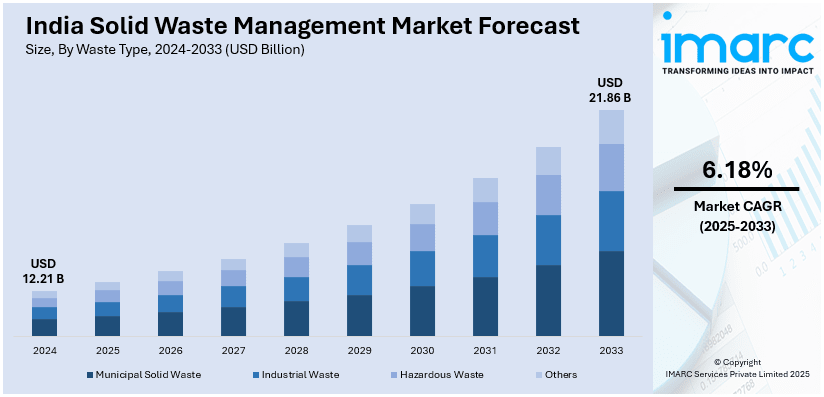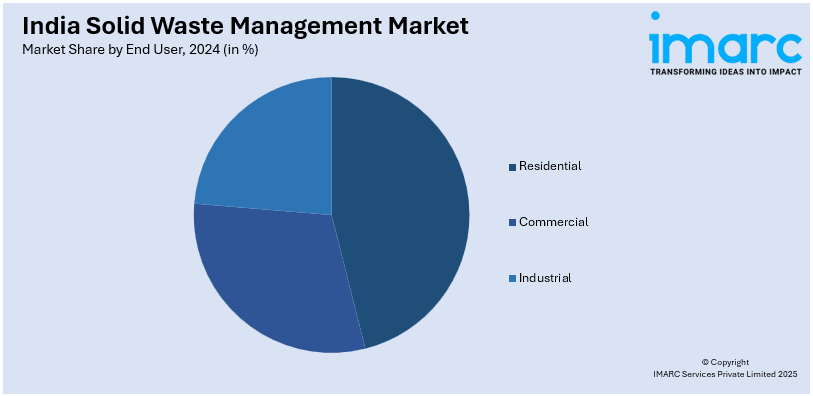
India Solid Waste Management Market Size, Share, Trends and Forecast by Waste Type, Service, End User, and Region, 2025-2033
India Solid Waste Management Market Size and Share:
The India solid waste management market size reached USD 12.21 Billion in 2024. Looking forward, IMARC Group expects the market to reach USD 21.86 Billion by 2033, exhibiting a growth rate (CAGR) of 6.18% during 2025-2033.Government regulations and policy initiatives, alongside the expansion of waste-to-energy technologies, are driving the India solid waste management market by promoting sustainability, encouraging compliance with waste management standards, and facilitating the development of innovative solutions, public-private partnerships, and energy production from waste.
|
Report Attribute
|
Key Statistics
|
|---|---|
|
Base Year
|
2024
|
|
Forecast Years
|
2025-2033
|
|
Historical Years
|
2019-2024
|
| Market Size in 2024 | USD 12.21 Billion |
| Market Forecast in 2033 | USD 21.86 Billion |
| Market Growth Rate 2025-2033 | 6.18% |
India Solid Waste Management Market Trends:
Government Regulations and Policy Initiatives
The growing emphasis of the governing body on environmental sustainability and waste management policies is offering a positive market outlook in India. The government is implementing a series of comprehensive initiatives aimed at enhancing waste management practices on a national scale. For instance, in 2024, the Government of India proposed new Solid Waste Management Rules, set to take effect on October 1, 2025. These rules mandated waste segregation, imposed fines on non-compliance, and empowered sanitation workers to penalize unsegregated waste. They also emphasized managing agricultural waste and introduced penalties for open burning, aiming to improve waste management across urban and rural areas. Complementing these regulations, initiatives like the Swachh Bharat Abhiyan have significantly promoted the importance of cleanliness, sanitation, and organized waste management systems. These government-led efforts are driving awareness and encouraging responsible waste disposal across both urban and rural regions. Moreover, by mandating stricter compliance with waste management standards, the regulatory landscape is creating opportunities for companies offering innovative waste management solutions. Increased public-private partnerships (PPP), financial investments, and the introduction of advanced waste management technologies are further contributing to the market growth. The focus of the governing body on sustainable waste management practices, coupled with enhanced infrastructure development, is ensuring a cleaner environment while fostering long-term economic growth in the waste management sector.

Expansion of Waste-to-Energy (WTE) Technologies
Waste-to-energy (WTE) technologies, which transform non-recyclable waste into electricity or heat, are increasingly becoming vital in advancing India’s solid waste management sector. With rising waste levels and restricted landfill space, WTE offers a sustainable approach by diminishing landfill waste and producing energy. This is especially important for India, where challenges in waste management and energy shortages are common. As a result, the Government is actively supporting WTE initiatives with financial incentives, subsidies, and policy backing to foster the broad implementation of these technologies. Private firms are making considerable investments in constructing WTE facilities, which are becoming essential components of urban waste management systems. In 2024, Union Home Minister inaugurated Gujarat's largest waste-to-energy plant in Ahmedabad. Located at Piplaj, the plant will process 1,000 metric tons of waste daily and generate 15 megawatts of electricity per hour. Developed in collaboration with Jindal Urban Waste Management Limited, the plant uses advanced technology to contribute to both waste management and energy production.
India Solid Waste Management Market Segmentation:
IMARC Group provides an analysis of the key trends in each segment of the market, along with forecasts at the regional level for 2025-2033. Our report has categorized the market based on waste type, service, and end user.
Waste Type Insights:
- Municipal Solid Waste
- Industrial Waste
- Hazardous Waste
- Others
The report has provided a detailed breakup and analysis of the market based on the waste type. This includes municipal solid waste, industrial waste, hazardous waste, and others.
Service Insights:
- Collection
- Disposal
- Recycling
A detailed breakup and analysis of the market based on the service have also been provided in the report. This includes collection, disposal, and recycling.
End User Insights:

- Residential
- Commercial
- Industrial
The report has provided a detailed breakup and analysis of the market based on the end user. This includes residential, commercial, and industrial.
Regional Insights:
- North India
- South India
- East India
- West India
The report has also provided a comprehensive analysis of all the major regional markets, which include North India, South India, East India, and West India.
Competitive Landscape:
The market research report has also provided a comprehensive analysis of the competitive landscape. Competitive analysis such as market structure, key player positioning, top winning strategies, competitive dashboard, and company evaluation quadrant has been covered in the report. Also, detailed profiles of all major companies have been provided.
India Solid Waste Management Market News:
- In March 2025, Pune became the first city in India to implement the central government's 'NAMASTE' scheme for waste pickers. This initiative officially recognizes waste pickers as workers, offering them social security, improved working conditions, and access to government welfare schemes. The scheme aims to uplift waste pickers and integrate them into the formal solid waste management system, ensuring a dignified and safer work environment.
- In July 2024, the Asian Development Bank (ADB) signed a $200 million loan agreement with the Government of India to enhance solid waste management and sanitation in 100 cities under the Swachh Bharat Mission 2.0. The program aimed to improve waste segregation, collection, and disposal while incorporating climate-resilient and gender-inclusive features.
India Solid Waste Management Market Report Coverage:
| Report Features | Details |
|---|---|
| Base Year of the Analysis | 2024 |
| Historical Period | 2019-2024 |
| Forecast Period | 2025-2033 |
| Units | Billion USD |
| Scope of the Report |
Exploration of Historical Trends and Market Outlook, Industry Catalysts and Challenges, Segment-Wise Historical and Future Market Assessment:
|
| Waste Types Covered | Municipal Solid Waste, Industrial Waste, Hazardous Waste, Others |
| Services Covered | Collection, Disposal, Recycling |
| End Users Covered | Residential, Commercial, Industrial |
| Regions Covered | North India, South India, East India, West India |
| Customization Scope | 10% Free Customization |
| Post-Sale Analyst Support | 10-12 Weeks |
| Delivery Format | PDF and Excel through Email (We can also provide the editable version of the report in PPT/Word format on special request) |
Key Questions Answered in This Report:
- How has the India solid waste management market performed so far and how will it perform in the coming years?
- What is the breakup of the India solid waste management market on the basis of waste type?
- What is the breakup of the India solid waste management market on the basis of service?
- What is the breakup of the India solid waste management market on the basis of end user?
- What is the breakup of the India solid waste management market on the basis of region?
- What are the various stages in the value chain of the India solid waste management market?
- What are the key driving factors and challenges in the India solid waste management market?
- What is the structure of the India solid waste management market and who are the key players?
- What is the degree of competition in the India solid waste management market?
Key Benefits for Stakeholders:
- IMARC’s industry report offers a comprehensive quantitative analysis of various market segments, historical and current market trends, market forecasts, and dynamics of the India solid waste management market from 2019-2033.
- The research report provides the latest information on the market drivers, challenges, and opportunities in the India solid waste management market.
- Porter's five forces analysis assist stakeholders in assessing the impact of new entrants, competitive rivalry, supplier power, buyer power, and the threat of substitution. It helps stakeholders to analyze the level of competition within the India solid waste management industry and its attractiveness.
- Competitive landscape allows stakeholders to understand their competitive environment and provides an insight into the current positions of key players in the market.
Need more help?
- Speak to our experienced analysts for insights on the current market scenarios.
- Include additional segments and countries to customize the report as per your requirement.
- Gain an unparalleled competitive advantage in your domain by understanding how to utilize the report and positively impacting your operations and revenue.
- For further assistance, please connect with our analysts.
 Inquire Before Buying
Inquire Before Buying
 Speak to an Analyst
Speak to an Analyst
 Request Brochure
Request Brochure
 Request Customization
Request Customization




.webp)




.webp)












